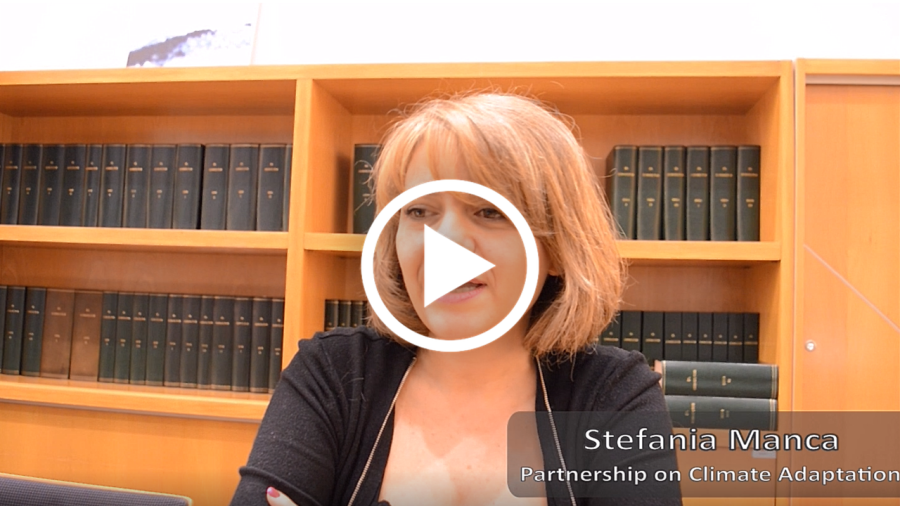
1. Good morning Stefania, could you tell us a bit more about yourself and your institution?
Well, I'm graduated in Natural Sciences with a master in GIS applied on environment and territory. In the last 4 years I have managed several European projects in the Municipality and I have gained experience in international collaborations and networking. I like working with different territorial realities, both in Italy and abroad, because only by comparison and true collaboration common goals can be achieved. Genoa Municipality counts 582.000 people that becomes 850.000 within its metropolitan area. It is a particular city with a fascinating landslides and a territory trapped between the hills and the sea. This asset conditioned its development in the past, especially in the coastal areas where industry, people, constraints and opportunities were mixed all together with a various territorial vulnerabilities that affect the urban development especially in the last decade. Today after a long renewal process this city is changing, reaching the objective to become smart and liveable for all people that live or visit it.
2. How does the Urban Agenda for the EU help Genoa reach this goal? Why did the Municipality decide to join?
The Urban Agenda is an inclusive, participatory instrument to reach a better Europeworking from the ground. It gave voice to cities that could dialogue with member state and EU Commission directly without main filters and express their needs with freedom, conscious to be part of a new experimental process. This is interesting and challenging at the same time, because medium and small cities are probably not used to working directly with the EU and they do not always know what that they have to do, but it is a really great opportunity to catch. Regarding Genoa city it was important to be part of this new mechanism, to put in place initiatives that work in a common vision of a new strategy to co-design a new urban area, able to face priority themes with a wider awareness.
3. What is your Partnership about? Who is involved?
We’re the Partnership on Climate Adaptation (including green infrastructure solutions). Our main challenges regard vulnerability assessments, climate resilience and risk management (including the social dimension of climate adaptation strategies). Adaptation to impacts and effects of climate relate extremes is a common challenge for all people in urban areas, all across Europe and in the entire world. Heat waves, Sea Level Rise, Flooding, Droughts, Loss of Biodiversity, Water Availability, health disease, shock and stress effects are a common ground from which it is necessary to go beyond.
The responsibility is to design concrete actions that help cities and urban areas to have a legal framework on climate adaptation, common guidelines to easily access to funds, more expertise in the cities to deal with a dynamic complex mechanism that is climate change, more effective decision-making tools and integrated territorial planning, thinking to which local level indicators could help to downscale models and upscale solutions, fighting uncertainty and gathering reliable useful data.
In our partnership we count on seven Local Authorities (Genova, Loulé, Trondheim, Potenza, Sfantu Gheorghe, Glasgow, Diba Barcelona), four Member States (France, Poland, Hungary, Bulgary), four Directorate General (DG REGIO, CLIMA, ENV, RTD) and four main organisations (CEMR, EUROCITIES, URBACT, EIB).
4. How is the Partnership work organized?
The partnership agreed to split into three main working groups, that would deal with a topic related to Governance, Knowledge and Resources. Since the beginning, they perform their analysis crossing elements referred to the main topics with three horizontal enabler issues: monitoring indicators, communication and sectoral impact. During the works of the preparatory phase, the partnership globally crosses 635 items and find 43 bottlenecks and 18 potentials. Partnership decides to top 8 bottlenecks and to put them in a public questionnaire to achieve feedbacks from cities in order to better understand if something is missing or underestimated. Now we’re approaching the design of the action to draft Action Plan ready to be submitted in June 2018.
5. What are the main obstacles and common ground you have encountered in your discussions?
The partnership works in a collaborative climate that has characterized all stages and all activities. Nevertheless, it is clear that the themes of discussion are different. Sometimes technical expertise is a key factor. For instance, in the governance working group, the discussion is every time really fruitful, although the only question remaining is how to downscale in the practice. We would like to have the possibility to compare our ideas with more Member States, more cities and more EU Commission representatives in the WG, especially when we assess actions.
6. How do you reach out to cities outside of your Partnership?
Both the Partnership and the Coordinator participate in several events, introducing and publicising the EU Urban Agenda and the Climate Adaptation Partnership. Coordinators have prepared a common presentation to bring to events and have planned a common calendar to share with partners. Furthermore, we have suggested the adoption of a communication strategy both at EU and local level. Some of these events are already available on Futurium, like the 8th Community of User Meeting, Genova Smart Week, Environmental FORUM Eurocities and so on.
7. What is coming up? What should we expect from your Partnership?
The partnership has met three times, including the kick-off meeting, and has held several conference calls in between to ensure the monitoring of the works and also to take care of all the needs expressed both from the coordinators and the working groups' leaders. Just to ensure public feedback and to start animating and mobilizing cities on the field of climate adaptation a questionnaire on the main bottleneck has been published on the official platform and the network belonging to the partnership and all the partners too will ensure its spread. It has also been translated in national languages to ensure the outreach at local level going forward the language barriers.
In general, the main aim of the partnership could be summarized below:
- to translate the needs of Cities, Member States and EU Commission Organizations in a common awareness level of the criticality of climate change and related impacts in urban areas;
- to establish a progressive enabler path, from basic to enhanced stage, to increase cities and people capacities in risks management, vulnerability assessment and to become climate resilience.



- Tagy
- climate Urban Agenda Climate Adaptation genoa interview Urban Agenda for the EU Stefania Manca Coordinator

